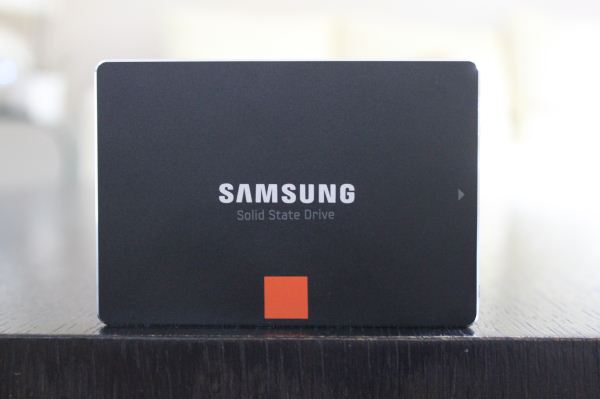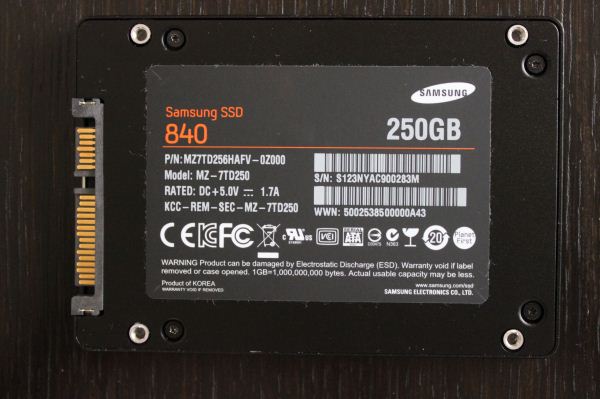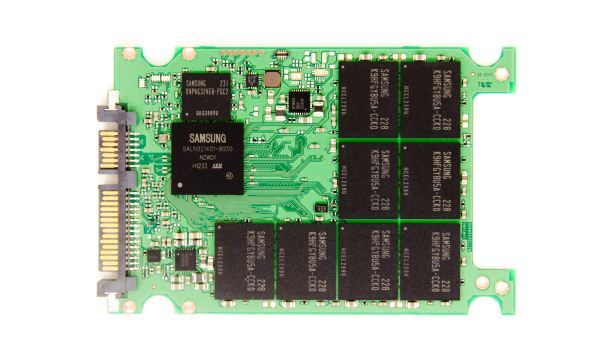Samsung SSD 840 (250GB) Review
by Kristian Vättö on October 8, 2012 12:14 PM EST- Posted in
- Storage
- SSDs
- Samsung
- TLC
- Samsung SSD 840
The Samsung SSD 840
Now it's time to look at the Samsung SSD 840 itself. Performance differences between different capacities are tangible. Sequential write speed in particular increase with larger capacities. With MLC NAND based SSDs 256GB and 512GB models usually perform around the same because 256GB of NAND is able to saturate the limits of the controller but as TLC NAND has longer program times, you will need more NAND dies to hide the additional latency.
| Samsung SSD 840 Specifications | |||
| Capacity | 120GB | 250GB | 500GB |
| Sequential Read | 530MB/s | 540MB/s | 540MB/s |
| Sequential Write | 130MB/s | 250MB/s | 330MB/s |
| 4KB Random Read | 86K IOPS | 96K IOPS | 98K IOPS |
| 4KB Random Write | 32K IOPS | 62K IOPS | 70K IOPS |
| Cache (LPDDR2) | 256MB | 512MB | 512MB |
| Samsung SSD 840 Pro vs 840 vs 830 | ||||
| Samsung SSD 830 (256GB) | Samsung SSD 840 (250GB) | Samsung SSD 840 Pro (256GB) | ||
| Controller | Samsung MCX | Samsung MDX | Samsung MDX | |
| NAND | 27nm Toggle-Mode 1.1 MLC | 21nm Toggle-Mode 2.0 TLC | 21nm Toggle-Mode MLC | |
| Sequential Read | 520MB/s | 540MB/s | 540MB/s | |
| Sequential Write | 400MB/s | 250MB/s | 520MB/s | |
| Random Read | 80K IOPS | 96K IOPS | 100K IOPS | |
| Random Write | 36K IOPS | 62K IOPS | 90K IOPS | |
| Warranty | 3 years | 3 years | 5 years | |
Performance wise the 840 does well but can't challenge the 840 Pro. Read performance is actually nearly on-par with the 840 Pro but write performance is behind due to the use of TLC NAND. I should add that write speeds are still adequate for a consumer drive. In some ways, the 840 can still be a healthy upgrade from the 830. Even though sequential write speed is lower, the increase in random read and write speeds can compensate. Still I suspect most 830 users will want to upgrade to the 840 Pro at least, if they choose not to wait for the next generation of SSDs.
| Samsung SSD 840 Series Pricing | ||||||
| 64GB | 128GB | 256GB | 512GB | |||
| Samsung SSD 840 | N/A | $109.99 (120GB) | $199.99 (250GB) | $449.99 (500GB) | ||
| Samsung SSD 840 Pro | $99.99 | $149.99 | $269.99 | $599.99 | ||
Pricing isn't as aggressive as it could be but keep in mind that the above prices are suggested retail prices. Street prices can easily be ~$20 less and I wouldn't be surprised to see the 120GB SSD 840 retailing for less than $100 (and even $70-80 when on sale). Also note that we're still very early in the production of TLC NAND. Over time you can expect a more appreciable difference in pricing between TLC and MLC NAND.
Based on the chassis alone you can't really tell the difference between the 840 and 840 Pro. Both use a similar matte black plastic design. The 840 measures in at 7mm tall as well, just like the 840 Pro. It's only when you flip the drive around that you can see that it's actually an 840 and not 840 Pro.
Unfortunately, we don't have any pictures of the internals at the moment. Samsung uses special pentalobe screws (similar to MacBook Air) and finding suitable screw drivers in Finland isn't as easy as in the US. In order to get the review out as soon as possible, we decided not to wait for the screwdriver to arrive from the US. We are, however, looking at a PCB that's indentical to the 840 Pro (i.e. eight 32GB TLC NAND packages). The only difference are NAND part numbers.
The 840 Pro
Test System
| CPU |
Intel Core i5-2500K running at 3.3GHz (Turbo and EIST enabled) |
| Motherboard |
AsRock Z68 Pro3 |
| Chipset |
Intel Z68 |
| Chipset Drivers |
Intel 9.1.1.1015 + Intel RST 10.2 |
| Memory | G.Skill RipjawsX DDR3-1600 2 x 4GB (9-9-9-24) |
| Video Card |
XFX AMD Radeon HD 6850 XXX (800MHz core clock; 4.2GHz GDDR5 effective) |
| Video Drivers | AMD Catalyst 10.1 |
| Desktop Resolution | 1920 x 1080 |
| OS | Windows 7 x64 |













86 Comments
View All Comments
travbrad - Wednesday, October 10, 2012 - link
I had a 80GB WD that lasted 8 years without failing. I eventually had to stop using it simply because it was too slow. I also had a 250GB WD drive that I used for 5 years (then switched to all SATA). Now I have a 640GB drive that I've been using for almost 4 years. My brother has a couple 500GB drives in his system that have been running for 4-5 years as well.Maybe I've just been really lucky, but the only drive I've personally had fail in the last decade was a Hitachi drive (obviously selected for cost not quality) in my HP laptop.
Now at work it's a different story. Those pre-built machines cut every corner they can to bring costs down so they end up with low quality components (especially PSUs). Even in that situation there is a fairly low number of hard drive failures though (considering how old most of the machines are)
mapesdhs - Friday, October 12, 2012 - link
I have SCSI disks that are more than 20 years old which still work fine. :D
Ian.
MarkLuvsCS - Monday, October 8, 2012 - link
Considering Write Amplification has been significantly reduced compared to the initial SSD tech, I don't believe it's going to be a problem for the consumer market. Google xtremesystems Write Endurance to see a Samsung 830 256gb with 3000 P/E still running at 4.77 PETABYTES.That page also shows you other brands and how they fare. I would trust Samsung wouldn't put this tech to use without truly understanding how it would pan out.That is why the worry of the 1000 P/E 840 vs 3000 P/E 830 is overblown. Either way you have little to worry about with Samsung's controllers causing any fuss unlike Other CompanieZ.
Kjella - Monday, October 8, 2012 - link
Not giving one fsck about wearing out the SSD I burned through a 10k-rated SSD in 1.5 years. Now with fairly normal SSD usage - a standard Win7 desktop with torrents etc. on other drives - I'm down to 57% health and looking at 3 years 10 months on a 5K-rated drive. I don't know exactly what is eating it but I'm guessing every log file, every time MSN or IRC logs a line of chat, every time something is cached or whatever it burns write cycles. I feel the official numbers are vastly *overstating* the actual lifespan, not understating it. TLC with 1K writes? Not in my machine, no sir.madmilk - Monday, October 8, 2012 - link
There's no way MSN/IRC can burn through an SSD in 1.5 years since they're all text. You must be doing something unusual, or at least your computer is without you knowing it. A good idea would be to open up Task Manager, and select the columns that count the number of bytes written by various programs. Maybe then you can find the source of your problem. Also make sure you have defragmentation off, and sufficient RAM so you're not constantly hitting the pagefile.piiman - Tuesday, February 19, 2013 - link
Better yet put the page file on a different drive and also move your temp folders to a different drive.Notmyusualid - Tuesday, October 9, 2012 - link
Absolutely hilarious ending there pal... I wonder how many people got it!I got burned by them on a couple of drives, and promptly dumped them on some well-known auction site, sold as-is.
creed3020 - Tuesday, October 9, 2012 - link
I see what you did there ;-)Great review Kristian! I'll be looking at this drive as option for a new office PC I am building.
B3an - Monday, October 8, 2012 - link
Did you people even bother to read?? Because you're conveniently missing out the important fact in this article that you'd have to write 36.5TiB (almost 40TB) a year for it to last 3.5 years. I know for a fact that the average consumer does not write anywhere near that much a year, or even in 3 years. If anyone even comes close to 40TB a year they would be using a higher-end MLC SSD anyway as they would surely be using a workstation.Most consumers don't even write 10GB a day, so at that rate the drive would easily last OVER 20 years. But of course it's highly likely something else would fail before that happens.
You're also forgetting out DSP which is explained in this article as well. That can also near double the life.
I think Kristian should have made this all more clear because too many people don't bother to actually read stuff and just look at charts.
futrtrubl - Monday, October 8, 2012 - link
Granted the usual use cases won't have so much data throughput. However those same usual use cases have the user filling 3/4 of the drive with static data (program/OS/photo archive etc) reducing the drive area it's able to wear level over. So that 20 years again becomes 5 years.Also the 1000PE cycle stat means that there is a 50% chance for that sector to have become unusable by that time (ignoring DSP).
I'm not saying that TLC is bad, and I am certainly not saying this drive doesn't have great value. I'm just saying that we shouldn't understate the PE cycle issue.